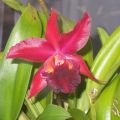


Donate Now
and become
Forum Supporter.

Many perks!
<...more...>


|

04-21-2007, 12:17 AM
|
|
Senior Member
|
|
Join Date: Mar 2007
Zone: 6a
Location: Southern Ontario
Posts: 752
|
|
Quote:
Originally Posted by Charles

Use powerdered cinnamon on the cut edges to avoid infection on the orchid. Put some on your finder and pack it into cut edge. You don't (can't, you'll see when you try it) want to use alot. A little will do.
When leaves are ready to come off, they will do so very easily. If you don't mind waiting, do that. It's always best to let the orchid do the deciding. Unless you are in a hurry before a show or some other event, wait.
|
Charles, what other kinds of things, if any, is cinnamon used for exactly?  |

04-21-2007, 07:56 AM
|
|
Senior Member
|
|
Join Date: Mar 2007
Zone: 9a
Location: Sunny Florida.
Posts: 314
|
|
Flavoring and cooking. It's also supposed to be good for you if you have diabetes.
Use cinnamon if the wound is still wet when you remove the leaf. It is used to close and protect the wound from infection. Think of it as a scab. It's made from bark. And it is nippy. If we were talking about people, the cinnamon would probably burn.
|

04-21-2007, 08:05 AM
|
 |
Senior Member
|
|
Join Date: Apr 2006
Zone: 9a
Location: Spring Hill, FL
Posts: 17,222
|
|
Cinnamon has been used for thousands of years for medicinal purposes  Only the best for our 'chids  |

04-21-2007, 11:20 AM
|
|
Senior Member
|
|
Join Date: Mar 2007
Zone: 6a
Location: Southern Ontario
Posts: 752
|
|
Thanks very much for cinnamon info. Love all these new tips!
|

04-21-2007, 05:53 PM
|
|
Senior Member
|
|
Join Date: Oct 2006
Location: Ukraine
Posts: 1,188
|
|
 And I always wait till the leaf falls by itself and then I take off the rest of the leaf that remains on the stem. |

04-21-2007, 05:55 PM
|
|
Senior Member
|
|
Join Date: Mar 2007
Zone: 6a
Location: Southern Ontario
Posts: 752
|
|
Good tip...that's what I've decided to do too.
|

04-21-2007, 06:20 PM
|
|
Senior Member
|
|
Join Date: Oct 2006
Location: Ukraine
Posts: 1,188
|
|
One more tip - tear the remains on few thin parts and then take these parts off one by one. If you pull off the whole thing at once you can tear it away together with the roots.
|

04-21-2007, 06:22 PM
|
|
Senior Member
|
|
Join Date: Mar 2007
Zone: 6a
Location: Southern Ontario
Posts: 752
|
|
That's very important advice...thanks again..
|

04-21-2007, 07:38 PM
|
|
Senior Member
|
|
Join Date: Mar 2007
Zone: 9a
Location: Palm Beach County, FL
Posts: 100
|
|
When cutting fleshy leaves, like on phals, I use a razor blade. Sometimes scissors damage the leaf, bruising the remaining tissue.
On this specific question, I cut into the leaf about an inch or two from the edge of any yellowing area. The nice thing about phals is that those cut leaves will be gone soon enough through regular growth.
Incidentally, the cinnamon is only effective for a few moments. It seals the wound (cut) and provides some antibacterial protections. It only takes a little.
I also give root balls a quick dusting of cinnamon after I've removed and cleaned a plant prior to repotting. Gives all those little scrapes from unpotting a little protection.
|

04-21-2007, 08:01 PM
|
|
Senior Member
|
|
Join Date: Mar 2007
Zone: 6a
Location: Southern Ontario
Posts: 752
|
|
I appreciate your valuable tips Rhonda, esp. with putting cinnamon on the roots! I'm always learning something new on this forum! By the way, I love your avatar. My little yellow leaf on my phal is a small one. The phal is one of 4 seedlings I bought last year and I just split it into 4 new phals...can't wait to see what I get. So, this leaf is probably one of the first seedling leaves anyway.
|
|
Currently Active Users Viewing This Thread: 1 (0 members and 1 guests)
|
|
|
 Posting Rules
Posting Rules
|
You may not post new threads
You may not post replies
You may not post attachments
You may not edit your posts
HTML code is Off
|
|
|
All times are GMT -4. The time now is 01:42 AM.
|


























 Only the best for our 'chids
Only the best for our 'chids 







 Linear Mode
Linear Mode


